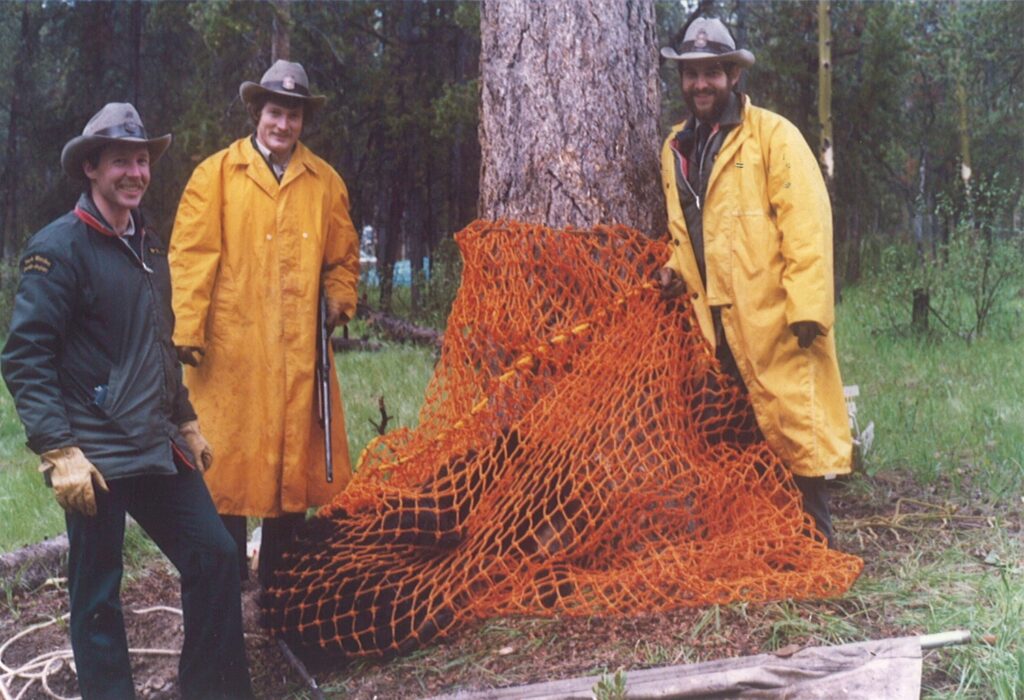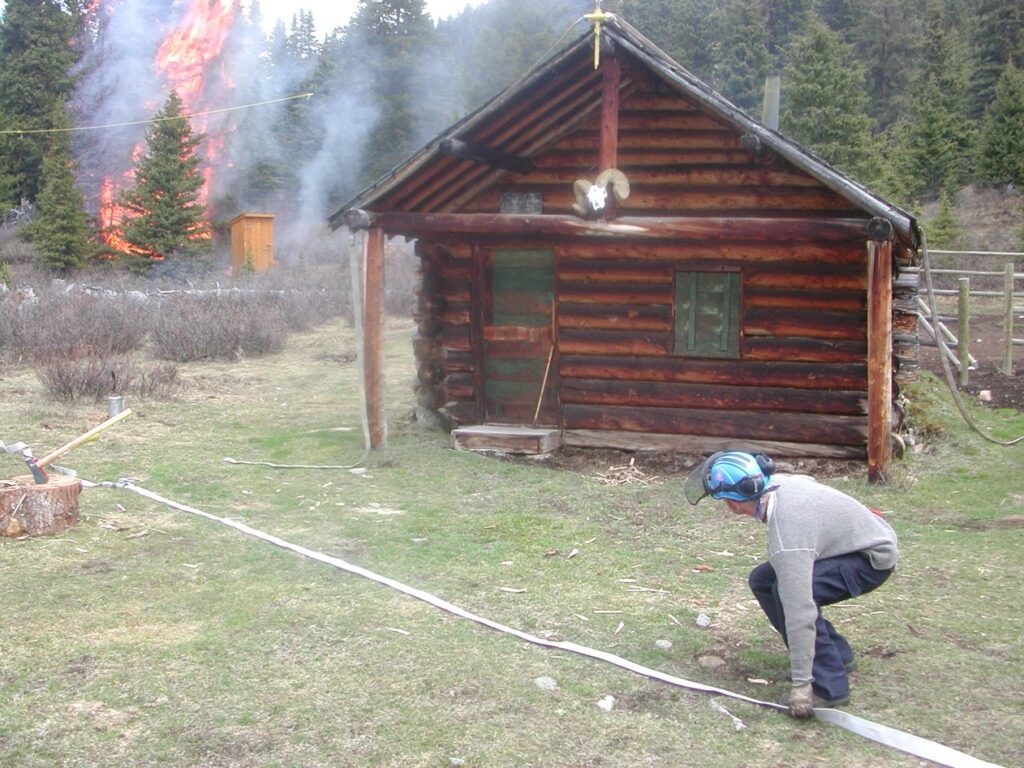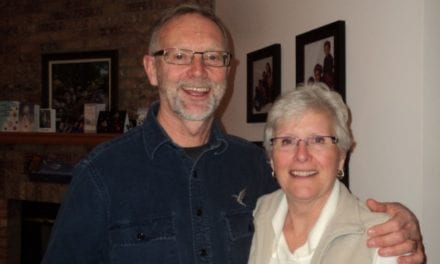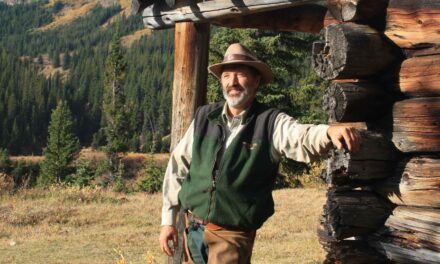Mac had purchased a new 20 HP Evinrude outboard motor and decided it was time to replace my old Mercury motor. I was kind of ambivalent about getting the Evinrude because it was heavier and more awkward to carry up and down the beach, and my old motor seemed to be running just fine. But I didn’t want to seem ungrateful and so I picked up the motor, and Ron Tessolini, the warden in the Broken Group, got my old one. One thing about my old Mercury was that the steering was a bit loose. Early one morning Ron was out doing a sea bird survey, standing up, glassing the water. The motor was still in gear, idling along but because of the loose steering, the boat kept turning off course. Frustrated, Ron tapped the steering shaft with his foot to keep the boat on course, but inadvertently knocked the throttle. The boat surged ahead, knocking Ron off balance. He fell over the back of the boat, but managed to grab onto the motor as he went over, his one leg deep in the water, his foot getting beaten up by the propeller. He managed to pull himself back on board and get the boat under control. It was a close call and he would have surely drowned had he not tackled the motor as he fell overboard.
A couple weeks later I heard Ron on the radio, calling in from the station in the Broken Group. “Mac,” he says, “this motor you gave me won’t go into forward gear, all I’ve got is reverse”. “Well”, Mac replied, “put it on the bow of your boat and come on back to Ucluelet!” Mac and everyone on the radio except Ron enjoyed the clever advice.
The Big Storm – 1980
In August of 1980 I was transferring from Pacific Rim to a permanent warden job in Banff. Frank Burstrom, a warden from Long Beach, had come down to get an orientation to the trail before I left. We spent a few days boating to various landings and hiked much of the trail between Thrasher Cove and Carmanah. From Carmanah, Frank was to hike alone to the Nitinat Narrows where Bill Smith was to meet him and show him around the north end of the trail. I loaded my boat and headed down the coast back to Port Renfrew. With calm sea conditions and a lightly loaded boat, I could make the trip in about 1 ½ hours. But there was a strong SE wind blowing that made for very choppy water and that slowed me down considerably. Every wave caused a severe jolt and I was feeling pretty beaten up as I climbed up the stairs from my boat launch. I could hear the phone ringing incessantly in the house. When I finally got inside and picked up the phone it was Bill Smith on the other end.
Bill had a smaller 14 foot zodiak, but had some of the roughest water on the West Coast to travel. When the tide is ebbing out of Alberni Inlet against the southwest wind, the swells and chop around Cape Beale can be very intimidating for boats of any size. This day was the worst sea conditions Bill had seen and after trying for over an hour to get around Cape Beale, he had to give up and returned to Bamfield. Could I go back up the coast and pick up Frank he asked? If not, the only way he could get Frank was to take his boat apart, drive to the head of Nitinat Lake, put it together and boat down the lake to the Nitinat bar. But all of this would take the best part of a day and it was already early afternoon. To complicate matters, Frank did not have a radio, tent, sleeping bag or food. What would Frank do when Bill failed to show up for him?
I agreed to head back up the coast but I knew from the time and the tide tables that I had to hurry or it would be impossible to get in and out over the Nitinat bar, the most dangerous river bar on the west coast of Vancouver Island. Nitinat Lake is a huge lake whose outlet is affected by the tides. When the tide is ebbing, especially near low tide huge swells break on the bar. The previous year a 7 metre-long Bayliner flipped over on the bar and the 2 men on board drowned. I quickly put together some food and camping gear, filled my gas tanks and headed back out in the storm.
I reached the whistle buoy at the entrance to San Juan Bay and turned up the outer coast. Now I was travelling with the wind at my back, and instead of beating into the chop, I was now surfing down the face of the waves and plowing into the back of the swells ahead of me. By now I was well aware that the shallow water off Bonila Point would be rough so I was a couple kilometers off shore hoping to avoid the worst of it. Suddenly the boat was picked up by a larger than usual wave and sent surfing down into the trough, burying the bow of the zodiac under the back of the wave ahead of me. Water was pouring into the boat. Before I could react, another similar wave picked up the boat and I slammed into another wave. This time, however, the water that was already in the boat rushed forward and held the bow under water even longer. Seawater was now swirling around my feet and the gas tanks. I realized that if another steep wave hit me, it would fill the boat completely and I would risk being washed overboard. I knew that there was little chance of survival if my boat drifted into the huge waves breaking on the rocks at Bonilla Point, but that didn’t worry me at all. That was because survival suits had not been invented yet. I was wearing a “floater coat”, and hip waders underneath nylon rain pants. It was a system that kept my feet and legs dry during surf landings, but if I got washed out of my boat the waders would fill up and I would sink like a stone.
I wasn’t sure what to do about the large steep waves but bailing out the boat seemed like the priority so I let the boat turn broadside to the waves and got to work getting the water out of the boat. Although there were a couple self-bailing ports in the transom, they did nothing unless you had some forward speed. From Renfrew to Bonilla point, the ocean was sheltered from southeast wind by Cape Flattery on the American side. Now moving up the coast from Bonilla Point I was fully exposed to the storm.
I slowed down so I didn’t drive the bow under any more waves and eventually I was clear of Bonilla Point and then passed by Carmanah Lighthouse. The Nitinat bar was still 12 kilometers away and I realized I was not going to get there in time to cross the bar before the tide started to ebb. I altered my course slightly, heading for the Cheewhat River where there is a bay with a headland and an offshore reef that protects the river mouth from the westerly swells. I was able to boat over the Cheewhat river bar without any problem but within a few minutes of landing the tide began to ebb, setting up a metre-high breaking wave on the bar. I was thankful to be off the ocean and I called the park office in Ucluelet to report my position.
The park radio system at the time had big gaps in coverage along the trail but fortunately it was working from my location. The next order of business was to get Frank. The main reason I had been trying to reach the Nitinat was that I had injured my left ankle and could barely walk. I now had to hobble the 3 kilometers from Cheewhat to Nitinat. As it was, I was already hours behind the meeting time arranged by Frank and Bill – would he still be there, standing around in the wind and rain? I found Frank patiently waiting in a leaky abandoned building, calmly, it appeared, smoking his hand rolled cigarettes.
We hiked back to the boat on the Cheewhat River arriving just before dark. Rather than pitch a tent in the wind and rain, we hiked another half kilometer to where there was a tourist cabin that Jim Hamilton rented out. It was empty so we arranged to rent it for the night and moved in. The next day, was still blustery, the waves breaking on the river mouth even at high tide and the swells remained white-capped. We were short of food, but fortunately, someone had left a substantial driftwood shelter on the beach with some food in it so we helped ourselves to the bread and peanut butter. The following day, at high tide, we were finally able to get over the bar at the river mouth and head home. The ocean swell was huge but glassy and we arrived at Port Renfrew without any further trouble.
SH: Can you tell me about any rescue/wildlife/enforcement stories that stick out in your memory?
One of the law enforcement events that stands out was one fall we were getting some training from Calgary City Police in what they called Code 300 takedowns. This is where you are stopping people in a vehicle, with full on lights, sirens, yelling. So we were doing this in Two Jack Campground which was closed. I was in a group with Joanne Williams, Ron LeBlanc and others I can’t remember. We were pulling over a vehicle and Larry Gilmar was a passenger. Everyone is yelling at him to get out of the car, screaming at him to do this and that. Somebody had a shotgun trained on Larry’s head and he reached over with one hand and grabbed the barrel of the shotgun and threw it across the car and out into the woods. We finally got him out of the car and there are four or five of us surrounding him. At one point in the melee Ron LeBlanc is yelling “Shoot him – he’s getting away!” Larry is such a huge guy, that we have two or three people on each arm trying to push his arms behind his back. Finally, we realize that he is not really resisting arrest, it is just that his shoulders are so stiff there’s no way he can put his wrists together. Then we also find out that the handcuffs are too small to go around his wrists. I think we gave Larry a stern talking to, and told him not to break any rules in the park and let him go. The city police and the plumbers that were working nearby were killing themselves laughing.
SH: Good one. What about a good wildlife story or a fire story Ian?
Ian: Well I have a lot of bear stories. I did bear management for a summer and a bit when I was in Banff. I will send you some bear stories …. Pick the one you like. (Tape 14:07)
Ian’s submitted bear story:
As fall approached we were still shoveling bears out of the Bow Valley, but they quickly returned. We needed to move them further. Perry Jacobson made a few phone calls to the BC Wildlife Office in Cranbrook – would they take one of our grizzlies? It was agreed, so a good-sized male, about 500 lbs would make the trip. First we had to move the bear from the culvert trap that he was caught in, into another trap that was more road-worthy. Using a jab stick and tranquilizing pistol, we administered a dose of drug. It is always difficult to judge the weight of a bear in a trap where it is often dark and the bears seem larger when they are snapping and roaring at you as you peer through the mesh peek holes. With the first dart, the bear showed signs that he got the drug, but he never fully went under. After an hour or so, he was recovering from the dose and we prepared a second dart. The same thing occurred – the bear was sluggish and slobbering, closing his eyes, but still not safe to pull out of the trap. Finally, we gave him a third dose of drug and eventually he did not respond to being poked with the ski pole and we opened the trap door, slid him onto the tarp and took our measurement and gave him a lip tattoo and ear tag. Then back into the other trap. It was late in the day by now, we would have to leave him in the trap overnight.
Since it was late in the fall and the bear was going to wake up in a completely different ecosystem, we wanted to give him a good meal to take him into hibernation. We loaded a bull elk that had been killed on the highway into the back of the truck. Early the next morning, Perry and I headed west, stopping in Radium for a coffee and to check on the bear. It seemed calm and was moving around in the trap a bit, nothing unusual. Next stop was Kimberley where we met the BC wildlife officers. They lead the way west on a number of logging roads until they felt it safe to release the bear.
We carefully, tied a rope from the trap door and ran it back through the truck window. Then with everyone safely in their trucks we pulled the rope and the trap door swung open. The bear remained in the trap, in spite of horning horns, sirens, and shouting. We now had to close the door again and see what was going on with the bear. I had the ski pole, and began poking the bear – no response. The four of us clustered around the trap, poking the bear and looking for some movement.
After half and hour or so the wildlife officers were getting impatient. That bear is dead one of them declared. It seemed he was right. Bears became dehydrated in a trap and this bear had been held for 3 days by now. Perry and I were disappointed that our efforts to save this bear from the “3 strikes – you’re out” policy had failed. While the Perry and the wildlife officers got their weapons and got ready to open the trap door, I continued jabbing the bear through the mesh. Suddenly, the bear let out a roar and charged the trap door. This sent us running for our trucks, but the catch on the trap door held. Cautiously we rigged the rope to the trap door again, and this time when we pulled the door open the bear wasted no time in exiting at a full run and disappeared over the bank. No one was saying too much, it was something none of us had experienced before, although my experience was pretty limited compared with the others. We unhooked the trap, and then unloaded the dead elk we had brought for the bear. With that, we headed back to Kimberley and on to Banff. Perry continued to look into the symptoms the bear showed and discussed it with a wildlife vet. What likely happened, the vet explained is that your darts were not long enough to deliver a full dose of drug into the muscle. Instead, the drug was absorbed by the fat that the bear had put on for the winter. The bear was slowly metabolizing the three doses of drug from the day before, drifting in and out of a drugged stupor. Lesson learned – order some longer needles for the bigger fatter bears.

Ian Pengelly, Mike Gibeau and Chris Worobets with bear in net.
SH: Do you want to talk about the fire program, burning anything by accident? (Tape 13:35)
Ian:. Well in 2003 I did burn the tops off a couple power poles that cut the power to Banff for a few hours and I did burn a half mile of rotten fence at the ranch that needed to be replaced. But I think we rarely get credit for all the power poles and facilities that we didn’t burn down like the outhouse at Divide cabin.
Ian: Overall, it was probably the more boring part of my career, lots of controversy and lots of paper work. What I did enjoy about the fire program was getting to travel, so I got up to Wood Buffalo 2 or 3 times, Nahanni National Park a couple of times, Prince Albert 3 times, Elk Island two or three times for prescribed fires. I made a trip to Nova Scotia and another to La Maurice. The best part of the fire program was meeting parks staff across Canada and getting to see a different part of the country that people worked in.

SH: Can you talk about teaching fire for years down in Marana, Arizona. (Tape 16:50)
Ian: I was an instructor down there on their prescribed fire course for ten years. What they wanted from me was a case study on planned ignition of coniferous forests. The Americans have very big programs for understory burning in things like ponderosa pine, burning shrubs and chaparral and in different places like the Florida Everglades but not much in the way of crown fire in coniferous forest. My lecture was talking about burning lodgepole pine and spruce forests, and how we overcame issues such as smoke or public opposition or opposition within our own Agency.
SH: How did the Warden Service change over the years? Centralization, affirmative action, focus on public safety, changes in the 1990s and 2000s…. (Tape 19:02)
Ian: I knew the older wardens like Earl Skjonsberg and Bill Vroom and John Wackerle, that worked under the district system up until 1968. They lived in a district and were responsible for everything that was going on in your district. I remember asking Bill Vroom what the job was back then. He looked at me like I was crazy and said, “Well your job was to survive.” It colored the Warden Service. They always kind of had that renegade attitude that I’m not going to be told how things should be. Stubborn independence was a valuable skill in the backcountry, to be able to look after yourself and have the strength and courage to travel alone in all kinds of weather and places. But stubborn independence didn’t work very well when we got into more complex things like ski area management or fire management, or environmental assessment. These jobs had shades of grey and you had to negotiate your position. It required a change in attitude which was slow in coming to the Warden Service I guess. It must have been frustrating for people like Jillian Roulet, or Charlie Zinkan and Dave Day, to try and herd these cats in a new direction.
SH: Do you want to talk about some of the changes in the latter part of your career? (Tape 21:48).
Ian: The answers to the next two questions overlap quite a bit…but mostly I want to say something different to the second question.
In the early ‘90s local people were really kind of up in arms about prescribed fire, and wildlife closures. There was this group called AAMPE that was trying to get people like Cliff White fired. That led to the Banff Bow Valley Study through 94/95 on to late 1996. We were very much under the microscope for those two and a half years. Right up until the report was published I don’t think any of us really knew which way things were going to go. That lead to 1997 Park Management Plan. That set the stage for resource management for the next ten or fifteen years.
The other big thing at that time was Canada Labor Code became law, largely in response to the Westray Mine disaster in Nova Scotia. But the effect of it was to put a lot more onus for the safety of the employee on the employer. That was a big shift in warden culture to go from being responsible for your own safety, to it being the responsibility of the supervisors and on up the line. That would be the thing that kind of curtailed the broad range of duties that most of us had.
SH: What about the Warden Service was important to you? – the Idea of protecting and preserving national parks, keeping people safe etc. (Tape 24:34)



